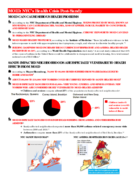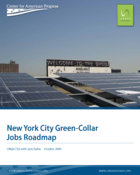
The Dangers of Mold after Hurricane Sandy
According to Mayor Bloomberg, Hurricane Sandy flooded 70,000 – 80,000 New York City homes. About 180,000 to 210,000 New Yorkers could be currently exposed to Sandy-related mold.

According to Mayor Bloomberg, Hurricane Sandy flooded 70,000 – 80,000 New York City homes. About 180,000 to 210,000 New Yorkers could be currently exposed to Sandy-related mold.

Initiated in 2008, the Green Collar Jobs Roundtable brought together 170 green employers, unions, workforce development providers and environmental justice organizations to develop a Green Collar Jobs Roadmap, a comprehensive policy proposal for jumpstarting New York’s green economy.

The Roundtable, convened by Urban Agenda, developed a Green Jobs Roadmap to identify concrete steps that our City’s leaders can take to develop a comprehensive, coordinated strategy to prepare New Yorkers for green collar jobs. The Roadmap represents the culmination of the great work done in the Roundtable process aimed at building an inclusive green economy for the City’s future.
Designed to make specific and targeted recommendations, the Green Jobs Roadmap creates a workforce development plan for green collar jobs.
Under a cap-and-trade plan to reduce greenhouse gas emissions, a limit is set on the amount of greenhouse gases (GHG) – carbon dioxide and five others - that can be emitted by regulated entities – e.g. the power plants that produce electricity, chemical refineries, and other carbon emitting industries. This is the cap.
Regulated entities purchase, or are given, allowances equal to the amount of GHG they will be emitting over a given period of time. For example, a power plant could be given x number of allowances for the x metric tons of CO2 they will be emitting through their operations. Entities that purchase more allowances than they need may sell additional allowances to entities that are unable to keep their emission level under the cap. This is the trade.
A cap may be set slightly higher than the existing level of GHG emissions across the participating sector. This limit is then gradually lowered, making allowances more expensive over time and reducing emissions – the ultimate goal. Cap-and-trade enables emitters to choose whether to reduce their emissions at the source, or, if this is prohibitively expensive, to purchase allowances from other emitters that have been able to reduce their own emissions.
Carbon dioxide is the most prevalent greenhouse gas produced by human activity, followed by methane, then ozone. Because greenhouse gases are carbon based, plans that monetize GHG emissions are considered to be “putting a price on carbon.”
Continue reading more on the elements of Cap-and-Trade, an alternative to cap-and-trade, existing cap-and-trade initiatives, and additional resources.

Urban Agenda, the New York City Central Labor Council and the New York City Environmental Justice Alliance have convened the Green Collar Jobs Roundtable in response to the growing need for workers with the green skills to make New York City more environmentally sustainable.